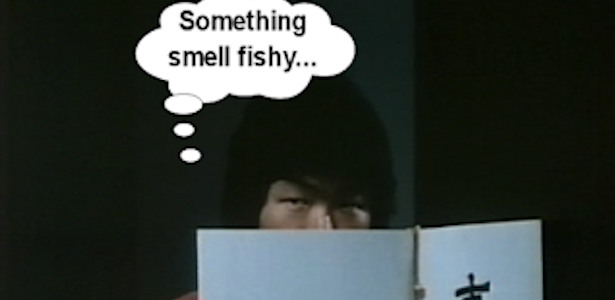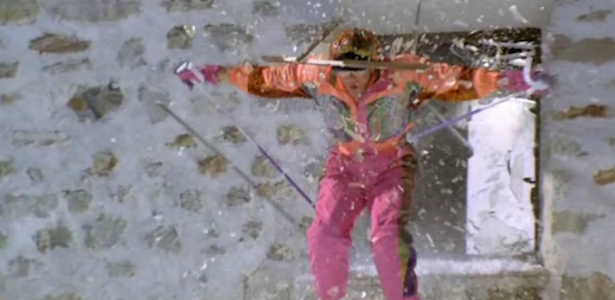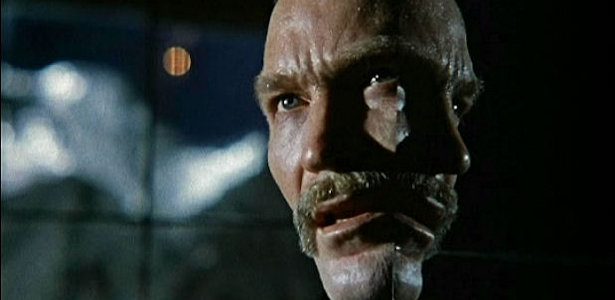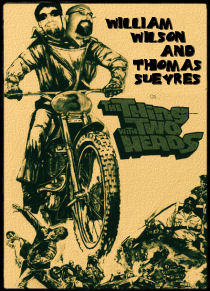Newton’s third law of motion states “to every action there is always an equal and opposite reaction”. This may be a principle of physics, but I believe it also applies to the way humans are wired in general. What is the action movie cliché? They pushed him too far, now he’s going to push back! The same can be said of the film industry when controlled by censorship, and the film industry is fueled by the demands of the audience. If a child is allowed to have anything they want except ice cream, what is that child going to want more than anything else? Of course it’s going to be ice cream. Cinematically this was demonstrated in bold print by the Franco era in Spain. Here in the US, it’s the ‘80s.
The ‘80s started off with the Iran Hostage Crisis (technically November of ’79), setting a tense mindset for the decade. The “Action Movie” was invented as a release for some of the political tensions, the rise of terrorism, corporate oppression and even worse, drugs and sex turning from acceptable recreational pastimes into a deadly debilitating epidemic. Horror movies played the same role, releasing the tension and dealing with public fears, but the one thing the majority of the public was not afraid of, was something the minority was. So flipped out about all the things that were going on in the world, a few religious wingnuts, scrambling for an explanation, decided that art and entertainment were to blame for all of the world’s ills. Actually, this is nothing new, but in the ‘80s it reached a fever pitch. Filmmakers wanted to deliver more cathartic thrills, and Jack Valenti and the MPAA, feverishly worked to deny them.
“But hey,” I hear you say, “isn’t censorship unconstitutional?” The answer is yes! To get around the fact that they were doing something unconstitutional Valenti and company stated that they were only providing a “voluntary” service that would rate the content of the films. Never mind that in order to get your movie shown or advertised, it had to have a rating. There was also a fee involved. Filmmakers had to submit the film, pay a fee based on a sliding scale determined by the film’s budget and receive some vague reports as to what they needed to remove from the film to obtain a specific rating. As if that wasn’t bad enough, the bigger your budget, the more connected you were and the more preferential your treatment. If you had a big budget movie like say ANGEL HEART (1987) were given specific instructions that allowed their films to get through with minimal submittals (excessive “buttock thrusts” during the sex scene, in case you were curious), and stuperstar movies like say, INDIANA JONES AND THE TEMPLE OF DOOM (1984) could slide through with a PG rating after showing a man getting his heart ripped out of his chest. Smaller budgeted movies, such as the notorious HENRY PORTRAIT OF A SERIAL KILLER (1986/1990) which was, like many other low-budget movies, given the cryptic reason that the “tone is too dark” for an R-rating. This requires edits based on the guesswork of the producers and costly resubmission, sometimes, as in the case of LEATHERFACE (1990), leading to re-shoots of scenes that were considered simply thematically offensive (a child setting off a contraption that kills someone is considered X-rated content).
Some of these movies that were heavily oppressed by the MPAA gained cult status simply because of this. The ‘80s had not only Jason Voorhees sending moral outrage throughout the minions of bible cults, but apparently 15th century covert operatives got their panties in a bunch too. While post-cert England has always been fussy about martial arts weapons in movies, we, the enlightened Americans, have never really had issues with that until Sam Firstenberg’s REVENGE OF THE NINJA (1983) came along. Of course, few martial arts films made in the US were as bloody as REVENGE. Newton’s law kicks in here as well. Whenever a movie (not made by Spielberg) sets a precedent for violence, the MPAA will come down hard on those that follow. Ask any director of the FRIDAY THE 13th sequels and they will recount the nightmare of multiple submissions and indirect answers.
 Hessler decides that if it ain't broke, don't fix it. Here Sho plays Akira Saito, a Japanese man who has descended from a long line of shinobi and secretly trains with his father. His wife Akia (Donna Kei Benz) talks him into moving his family to the violent land of America. Once there the old man who sells them the house, Sam (TV vet Parley Baer) tells him it’s a bad neighborhood and to keep their doors locked (I guess escrow already went through). So now you know shit’s gonna go down. For some reason the local mob uses the shed behind their new house as a drop point for stolen merchandise. After a dirty cop decides to steal a pricessless necklace instead of leaving it in the shed, the mobsters decide it’s time to crack some skulls! Their first suspect is Sam, who they catch on the way out of town. They decide that sorting through all of his stuff (which is all tied to his car) is too time consuming, so they simply beat him to death and set his car on fire. Hey now, these are the same guys who think that nothing is conspicuous at all about armed guys in suits stopping in a suburban neighborhood, and going into someone’s back yard to make illegal deals! This is actually one of the first cuts in the movie. In the edited version Limehouse Willie (James Booth in a slimy role that he wrote for himself) hits Sam's car with a crowbar, shouting “liar!” He then raises the crowbar to hit Sam, and we cut to Limehouse's henchmen dousing the car with gas. In the uncut version, Limehouse beats Sam repeatedly with the crowbar, shouting “liar!” with each hit, until one of his lackeys stops him, apparently feeling that it is acceptable to kill someone with a crowbar, but hitting them after they are already dead is an embarrassing breach of etiquette. I realize that beating ol' gramps to death with a blunt object isn't exactly a nice thing to do, but if movie mobsters only did things that would only be acceptable behavior in films such as, say PETE'S DRAGON (1977), there would be no need for the ninja to get revenge and thus no movie. Which is exactly what the MPAA wanted. And probably Leonard Maltin too.
Hessler decides that if it ain't broke, don't fix it. Here Sho plays Akira Saito, a Japanese man who has descended from a long line of shinobi and secretly trains with his father. His wife Akia (Donna Kei Benz) talks him into moving his family to the violent land of America. Once there the old man who sells them the house, Sam (TV vet Parley Baer) tells him it’s a bad neighborhood and to keep their doors locked (I guess escrow already went through). So now you know shit’s gonna go down. For some reason the local mob uses the shed behind their new house as a drop point for stolen merchandise. After a dirty cop decides to steal a pricessless necklace instead of leaving it in the shed, the mobsters decide it’s time to crack some skulls! Their first suspect is Sam, who they catch on the way out of town. They decide that sorting through all of his stuff (which is all tied to his car) is too time consuming, so they simply beat him to death and set his car on fire. Hey now, these are the same guys who think that nothing is conspicuous at all about armed guys in suits stopping in a suburban neighborhood, and going into someone’s back yard to make illegal deals! This is actually one of the first cuts in the movie. In the edited version Limehouse Willie (James Booth in a slimy role that he wrote for himself) hits Sam's car with a crowbar, shouting “liar!” He then raises the crowbar to hit Sam, and we cut to Limehouse's henchmen dousing the car with gas. In the uncut version, Limehouse beats Sam repeatedly with the crowbar, shouting “liar!” with each hit, until one of his lackeys stops him, apparently feeling that it is acceptable to kill someone with a crowbar, but hitting them after they are already dead is an embarrassing breach of etiquette. I realize that beating ol' gramps to death with a blunt object isn't exactly a nice thing to do, but if movie mobsters only did things that would only be acceptable behavior in films such as, say PETE'S DRAGON (1977), there would be no need for the ninja to get revenge and thus no movie. Which is exactly what the MPAA wanted. And probably Leonard Maltin too.
Of course one thing leads to another, one of Saito’s kids (Shane Kosugi) is kidnapped, his wife and that same unlucky son are run down by a car, and finally the wife is assaulted and murdered in the hospital. Now Saito is going to “go back to the shadows” and enforce Newton’s third law. Oh yeah, time for some equal and opposite reaction, muthafuggas!

PRAY FOR DEATH really signaled the end of the violent ninja movies. Even Mats Helge toned down his RUSSIAN NINJA, the 1989 follow-up to his gory classic NINJA MISSION (1984). For one, Sho Kosugi wanted to pursue other types of projects and like Bruce Lee before him, there was really no-one else to fill his lethal footwear (though like Lee, that didn't stop anyone from trying). Also, the film had a brutal time making it through the MPAA’s meatgrinder. It was heavily edited and that cut version was distributed to almost all other markets. Even countries that normally only buy the unedited versions of films for distribution, such as Japan and Holland, for whatever reason ended up with the censored release. This has led to long speculation about the graphic content that it once held. It’s long been believed that there was some very extreme footage left on the cutting room floor that warranted an X-rating. Years back I finally got my hands on the long rumored uncut version of DEATH WISH II (1982), and that film had some footage that understandably caused some sphincter clenching in the MPAA’s screening room. It has long been thought that PRAY FOR DEATH ran along the same lines. I’m here to tell ya, it ain’t so. If anything, PRAY FOR DEATH is the epitome of the MPAA’s total lack of objectivity and extreme hypocrisy in the ‘80s.

The basic cruxt of the movie is a back and forth between the mob’s main lackey, Limehouse and Saito. After Saito goes to the docks to meet with Limehouse to get his son back, Saito is shackled and Limehouse uses a balisong to slice Saito’s chest. In the cut version we see Limehouse over Saito’s shoulder doing the cutting, there is a few reaction shots from both and then a shot of a line of blood across Saito’s chest drawn by the knife. In the uncut print, there is a shot of the knife starting to cut into Saito’s chest before the reaction shots. Apparently two shots of a knife drawing a line of blood across someone’s chest is X-rated! Later there is a shot of Limehouse slashing his own forearm with the balisong to get into the hospital where Saito’s wife and son are. There is no prosthetic effect in either of these shots, simply the old trick of having a tube on the opposite side of the blade that pushes a bit of blood out as the dull knife is moved across the skin. Oldest trick in the book and apparently… X-rated!
Once Limehouse is in the hospital he heads to Aiko Saito’s room where it has often been rumored a major edit occurs. In fact, this is true. Almost the entire scene is missing from the cut version. Limehouse enters the room slams a strip of gauze over Aiko’s mouth and then a big clumsy cut to the cops and the detective in the hospital. It has often been speculated that the scene was a graphic rape, complete with genital mutilation. This is only partially true. In the uncut scene, Limehouse savagely beats Aiko with a closed fist three times, rips her top open and lifts one of her legs up. We cut away to a police detective and a patrolman in the hallway, so if he does rape her, it is completely implied. We cut back and he’s making a grunting, stabbing motion and lifts a bloody pair of scissors. None of the stabbing is shown, but it could be taken as implied that he is stabbing her in the abdominal region. Either way, it is a rough scene, but X-rated? Hardly. So extreme that the entire scene had to be cut? Totally ridiculous, but the MPAA had an agenda, and they would not be denied.
 The second of the two major cuts in the film is the scene where Limehouse machineguns dirty cop Joe Daley (Matthew Faison) in a supremely cheesy Italian restaurant (why are Mafioso types eating at a Fuzio’s type of place?). Limehouse is shown firing the gun, but the shot of Joe and his contact being peppered with lead is missing, as is the rest of the violence. After Limehouse presumably kills Joe, he shoots up the restaurant decorations, is shown nudging Joe's corpse with his shoe, spits on the floor and that’s it for the cut version. In the uncut version of the sequence, Limehouse guns down some of the diners hitting the restaurant decorations in the process and we see Joe’s body face-down on the floor. Limehouse uses his foot to turn him over showing him covered in blood, then Limehouse spits on his corpse. Yep, that’s X-rated too! But wait! It gets better. Limehouse hears some whimpering coming from behind the bar, so he walks over looks down at someone off camera and says “hey, what’s the matter? I ain’t gonna hurt you”, a quick insert shot of a girl standing up and then he fires two shots and we cut to a quick insert of the girl dropping out of frame. Not even a squib is present in this bit and the girl isn’t even in the same shot, but somehow, yes, this is X-rated material! Will pointed out something that I completely missed. This cut was undoubtedly a knee-jerk reaction to the infamous McDonald's massacre of the Summer of 1984. The second largest one-day, single-person mass murder in recent US history, having that scene in a film mere months after the fact probably was a little too close to the bone. Regardless, it's not the responsibility of a supposedly objective ratings board to decide what the public, or in fact the world, is in the mood to see, but to rate the content of films to advise the movie-going public. A concept Valenti only gave lip-service to.
The second of the two major cuts in the film is the scene where Limehouse machineguns dirty cop Joe Daley (Matthew Faison) in a supremely cheesy Italian restaurant (why are Mafioso types eating at a Fuzio’s type of place?). Limehouse is shown firing the gun, but the shot of Joe and his contact being peppered with lead is missing, as is the rest of the violence. After Limehouse presumably kills Joe, he shoots up the restaurant decorations, is shown nudging Joe's corpse with his shoe, spits on the floor and that’s it for the cut version. In the uncut version of the sequence, Limehouse guns down some of the diners hitting the restaurant decorations in the process and we see Joe’s body face-down on the floor. Limehouse uses his foot to turn him over showing him covered in blood, then Limehouse spits on his corpse. Yep, that’s X-rated too! But wait! It gets better. Limehouse hears some whimpering coming from behind the bar, so he walks over looks down at someone off camera and says “hey, what’s the matter? I ain’t gonna hurt you”, a quick insert shot of a girl standing up and then he fires two shots and we cut to a quick insert of the girl dropping out of frame. Not even a squib is present in this bit and the girl isn’t even in the same shot, but somehow, yes, this is X-rated material! Will pointed out something that I completely missed. This cut was undoubtedly a knee-jerk reaction to the infamous McDonald's massacre of the Summer of 1984. The second largest one-day, single-person mass murder in recent US history, having that scene in a film mere months after the fact probably was a little too close to the bone. Regardless, it's not the responsibility of a supposedly objective ratings board to decide what the public, or in fact the world, is in the mood to see, but to rate the content of films to advise the movie-going public. A concept Valenti only gave lip-service to.
The rest of the missing footage is little bits here and there that add up to quite a bit. While in the hospital Limehouse is attacked by some cops and he fights them off with his fists and a pair of scissors. It’s hard to tell he’s even stabbing them with the scissors, except in the uncut print there is a shot of one of the cops on the floor with a pair of scissors sticking out of his chest. You got it… X-rated! When Saito kills Limehouse's boss with the folding super-shuriken thing, there is an extra shot of the door swinging open, showing that one of the spokes punched through the door and a patch of blood. During the climactic battle in the mannequin factory, Limehouse stabs Saito in the leg with a square dowel rod. In the cut version you see the rod going into Saito’s leg via forced perspective (it’s pretty clear that it’s going behind his leg). In the uncut version Limehouse gives it a couple of twists after sticking it in. Also there are several shots of the rod in the wound, an extra shot of it getting twisted in the wound and blood running out and a shot of the broken rod being pulled out of the wound. Is it violent? Well, yeah. But that's why we have an R-rating; to advise people that the content of the film might not be for the squeamish. Just in case the title PRAY FOR DEATH and the image of a ninja in body armor didn't deliver the message and you went into the theater expecting THE APPLE DUMPLING GANG (1975).
 It’s easy to speculate on the missing footage from Limehouse’s final comeuppance, but there is no extra footage of him meeting his end in the saw blade. There is, however, a quick close-up shot of his bloodless hand impaled on the log and a shot of his leg being stabbed. The shot of his leg being stabbed is particularly surprising since it is simply a shot of a hand quickly stabbing a piece of black cloth, again, without any blood or effects whatsoever!
It’s easy to speculate on the missing footage from Limehouse’s final comeuppance, but there is no extra footage of him meeting his end in the saw blade. There is, however, a quick close-up shot of his bloodless hand impaled on the log and a shot of his leg being stabbed. The shot of his leg being stabbed is particularly surprising since it is simply a shot of a hand quickly stabbing a piece of black cloth, again, without any blood or effects whatsoever!
While the US never went through the insanity of England’s notorious “video nasty” era, we definitely had our own version of wildly inconsistent censorship that in hindsight seems even more absurd than it did at the time. Things like this make it even more grating to read the likes of Eli Roth whining about the MPAA, parroting the filmmakers of the ‘80s who could barely get their films rated R, even after cutting them to pieces.























































.jpg)
















